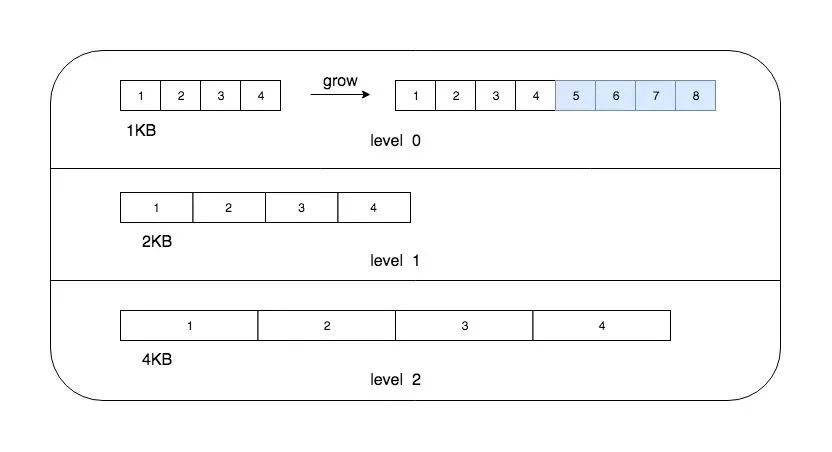上个月,牙膏厂intel因为Meltdown和Spectre两个bug需要给CPU固件和系统打了补丁。我们生产环境使用的是阿里云,打完补丁后,几台IO密集型的机器性能下降明显,从流量和cpu load估计,性能影响在50%左右,不是说好的最多下降30%麽。
在跑的业务是go写的,使用go pprof对程序profiling了一下,无意中发现,目前的系统gc和malloc偏高。其中ioutil.ReadAll占用了可观的CPU时间。
ioutil.ReadAll为什么慢?
这个函数的签名原型是func ReadAll(r io.Reader) ([]byte, error). 团队的小伙伴非常喜欢用这个函数,其中一个原因是这个函数可以将r中的数据一次性读完返回,不需要关心内存如何分配、如果分配的内存不够了,如何进行内存扩张等。作为一个util函数,这样设计是完全没问题的。但是,IO密集场景下,这个函数的开销就是你需要关心的了。这个函数实际调用realAll读取数据:
// readAll reads from r until an error or EOF and returns the data it read
// from the internal buffer allocated with a specified capacity.
func readAll(r io.Reader, capacity int64) (b []byte, err error) {
buf := bytes.NewBuffer(make([]byte, 0, capacity))
// If the buffer overflows, we will get bytes.ErrTooLarge.
// Return that as an error. Any other panic remains.
defer func() {
e := recover()
if e == nil {
return
}
if panicErr, ok := e.(error); ok && panicErr == bytes.ErrTooLarge {
err = panicErr
} else {
panic(e)
}
}()
_, err = buf.ReadFrom(r)
return buf.Bytes(), err
}
其中,capacity是常量值512. realAll函数在调用buf.ReadFrom进行数据读取:
// ReadFrom reads data from r until EOF and appends it to the buffer, growing
// the buffer as needed. The return value n is the number of bytes read. Any
// error except io.EOF encountered during the read is also returned. If the
// buffer becomes too large, ReadFrom will panic with ErrTooLarge.
func (b *Buffer) ReadFrom(r io.Reader) (n int64, err error) {
b.lastRead = opInvalid
// If buffer is empty, reset to recover space.
if b.off >= len(b.buf) {
b.Reset()
}
for {
if free := cap(b.buf) - len(b.buf); free < MinRead {
// not enough space at end
newBuf := b.buf
if b.off+free < MinRead {
// not enough space using beginning of buffer;
// double buffer capacity
newBuf = makeSlice(2*cap(b.buf) + MinRead) // 1 扩张内存
}
copy(newBuf, b.buf[b.off:]) // 2 拷贝内容
b.buf = newBuf[:len(b.buf)-b.off]
b.off = 0
}
m, e := r.Read(b.buf[len(b.buf):cap(b.buf)])
b.buf = b.buf[0 : len(b.buf)+m]
n += int64(m)
if e == io.EOF {
break
}
if e != nil {
return n, e
}
}
return n, nil // err is EOF, so return nil explicitly
}
看到这里,原因就非常清楚了:如果要读取的数据大小超过了初始buf大小(默认初始大小为512 bytes), 则会重新分配内存,并拷贝内容到新的buffer中。如果要读取的数据非常大,则会重复多次上述操作。那么优化的问题就转化为如何降低内存重分配和拷贝。
多级内存池的设计和实现

1. 内存池被按照大小被分为多级。如上图所示,(0, 1024]使用level 0, (1024, 2048]使用level 1. 内存池分级有两个好处:
A. 可以灵活的规划不同级别内存池的总大小和item数量,适应不同业务。
B. 实现层面上,可以将一把内存池大锁拆分成多个小锁,减少锁争抢。
2. 当已分配的内存池耗尽需要扩张时,一次性申请一大块内存,提高扩张效率。如level 0所示。
3. 代码实现gmmpool,bench结果显示性能提高约19倍:
BenchmarkStdReadAll-4 200000 5969 ns/op
BenchmarkMultiLevelPool-4 5000000 311 ns/op
小结
对于频繁进行内存分配和释放的场景,使用内存池可以显著降低golang运行时的开销。同时也要注意,内存池的内存交给了用户管理,你需要小心检查是否存在内存泄露问题。如果你对性能要求没有这么苛刻,只是想复用一些小对象,那么我们推荐你使用标准库的sync.Pool.
另外,开头提到的阿里云性能问题,即使使用了内存池优化,结果还是非常悲剧。最后阿里云帮我们更换了没有打牙膏厂补丁的机器解决。是不是非常惊喜?
出处:https://liudanking.com/arch/golang-multi-level-memory-pool-design-implementation/

架构文摘
ID:ArchDigest
互联网应用架构丨架构技术丨大型网站丨大数据丨机器学习

更多精彩文章,请点击下方:阅读原文
